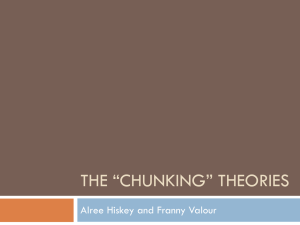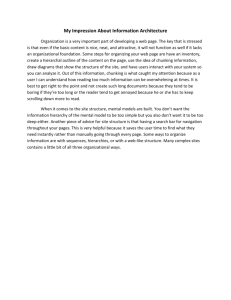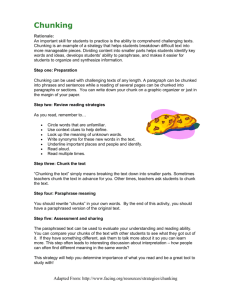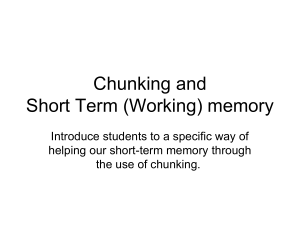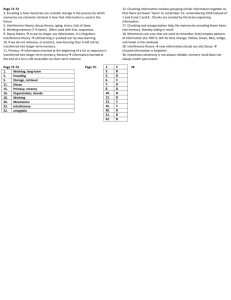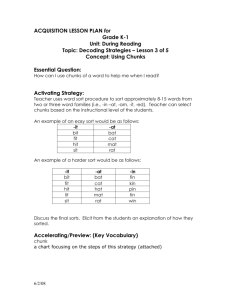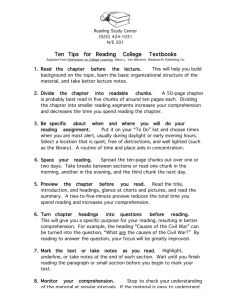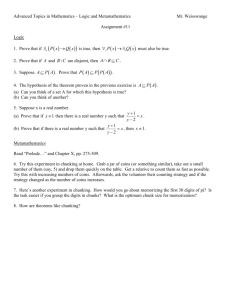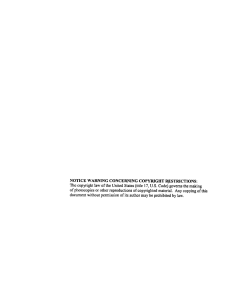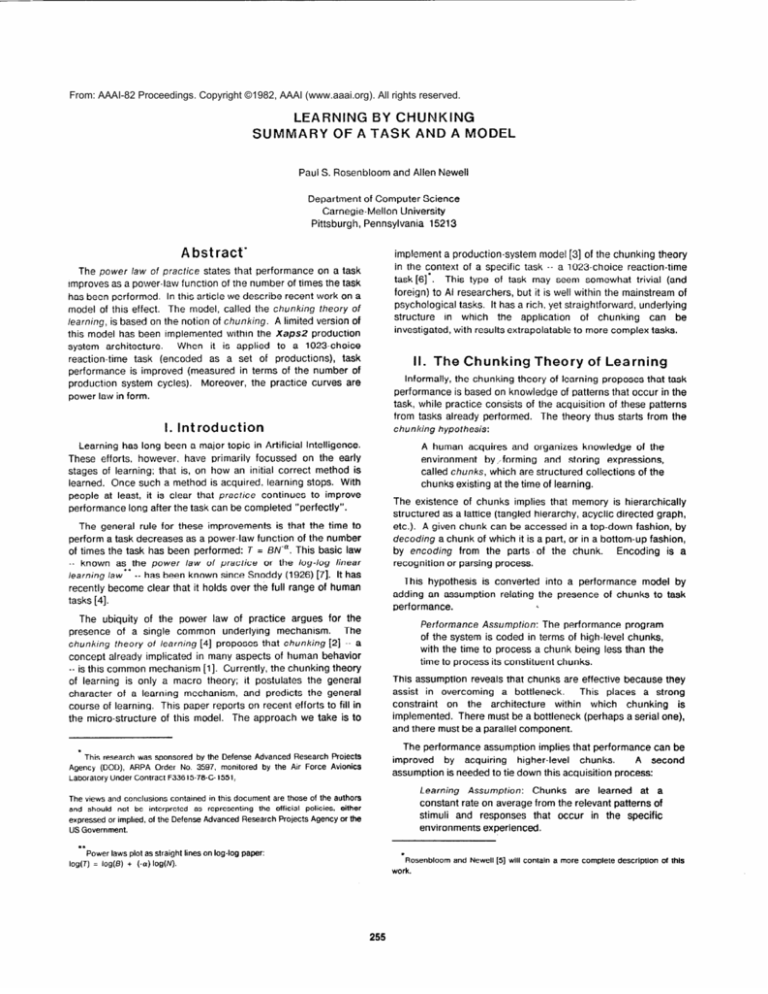
From: AAAI-82 Proceedings. Copyright ©1982, AAAI (www.aaai.org). All rights reserved.
LEARNING BY Cl-KINKING
SUMMARY
OF A TASK AND A MODEL
Paul S. Rosenbloom
and Allen Newell
Department of Computer Science
Carnegie-Mellon
University
Pittsburgh, Pennsylvania
15213
Abstract‘
implement a production-system
model [3] of the chunking theory
in the context of a specific task -- a 1023choice
reaction-time
task [6]*.
This type of task may seem somewhat trivial (and
foreign) to Al researchers, but it is well within the mainstream of
psychological tasks. It has a rich, yet straightforward,
underlying
structure
in which
the application
of chunking
can be
investigated, with results extrapolatable to more complex tasks.
The power law of practice
states that performance on a task
improves as a power-law function of the number of times the task
has been performed. In this article we describe recent work on a
model of this effect. The model, called the chunking theory of
/earning, is based on the notion of chunhing. A limited version of
this model has been implemented within the XapsP production
When it is applied to a 1023choice
system architecture.
reaction-time
task (encoded
as a set of productions),
task
performance is improved (measured in terms of the number of
Moreover, the practice curves are
production system cycles).
II. The Chunking
power law in form.
I. Introduction
chunking
Learning has long been a major topic in Artificial Intelligence.
These efforts, however, have primarily focussed on the early
stages of learning; that is, on how an initial correct method is
learned. Once such a method is acquired. learning stops. With
people at least, it is clear that practice
continues to improve
performance long after the task can be completed “perfectly”.
This hypothesis is converted
into a performance
model by
adding an assumption relating the presence of chunks to task
A
performance.
The ubiquity of the power law of practice argues for the
presence of a single common underlying
mechanism.
The
chunking
theory of learning
[4] proposes that chunking
[2] -- a
concept already implicated in many aspects of human behavior
_- is this common mechanism [l]. Currently, the chunking theory
of learning is only a macro theory; it postulates the general
character of a learning mechanism, and predicts the general
course of learning. This paper reports on recent efforts to fill in
the micro-structure
of this model. The approach we take is to
Agency
(DOD),
Laboratory
was sponsored
ARPA
Order
Under Contract
by the Defense
No.
3597,
monttored
Advanced
Research
by the
Air Force
hypothesis:
The existence of chunks implies that memory is hierarchically
structured as a lattice (tangled hierarchy, acyclic directed graph,
etc.). A given chunk can be accessed in a top-down fashion, by
decoding
a chunk of which it is a part, or in a bottom-up fashion,
by encoding
from the parts of the chunk.
Encoding
is a
recognition or parsing process.
recently become clear that it holds over the full range of human
tasks [4].
This research
of Learning
A human acquires and organizes knowledge of the
environment
by ,,,forming and storing expressions,
called chunks, which are structured collections of the
chunks existing at the time of learning.
The general rule for these improvements
is that the time to
perform a task decreases as a power-law function of the number
of times the task has been performed: T = BNsa. This basic law
__ known as the power
law of practice
or the log-log
linear
learning
law** -- has been known since Snoddy (1926) [7]. It has
*
Theory
Informally, the chunking theory of learning proposes that task
performance is based on knowledge of patterns that occur in the
task, while practice consists of the acquisition of these patterns
from tasks already performed.
The theory thus starts from the
Assumption:
The performance program
of the system is coded in terms of high-level chunks,
with the time to process a chunk being less than the
time to process its constituent chunks.
Performance
This assumption reveals that chunks are effective because they
assist in overcoming
a bottleneck.
This places a strong
constraint
on the architecture
within
which
chunking
is
implemented. There must be a bottleneck (perhaps a serial one),
and there must be a parallel component.
The performance assumption implies that performance can be
improved
by acquiring
higher-level
chunks.
A second
assumption is needed to tie down this acquisition process:
Projects
Avionics
F33615-78-C-1551,
Assumption:
Chunks
are learned
at a
constant rate on average from the relevant patterns of
stimuli and responses that occur in the specific
environments experienced.
Learning
The views and conclusions
and
should
expressed
not
be
or impked,
contained
interpreted
as
of the Defense
in this document
representing
Advanced
the
Research
are those of the authors
official
Projects
policies,
Agency
either
or the
US Government.
..
Power
log(T)
laws plot as straight
= log(B)
lines on log-log
paper:
*Rosenbloom
+ (-a)log(fV).
work.
255
and Newell
[5] will contain
a more complete
description
of this
The final assumption made by the chunking theory of learning
ties performance to the structure of the task environment.
Task Structure
Assumption:
recurrence of an environmental
the pattern size increases.
The probability
pattern decreases
of
as
This assumption is trivially true for the typical combinatorial
task
environment, composed of a set of objects that can vary along a
set of dimensions.
As the pattern size grows (in terms of the
number of dimensions specified), the number of possibilities
grows exponentially.
Any particular large pattern will therefore
be experienced less often than any particular small pattern.
III.
The Task
The task that we employ is Seibel’s 1023-choice reaction-time
task [6].
The environment
for this task consists of a roughly
linear (horizontally) stimulus array of ten lights, and a response
array
of ten buttons
(in a highly
compatible
one-one
correspondence
with the lights). On each trial, some of the lights
are On, and some are Off. The subject’s task is to respond by
pressing the buttons corresponding
to the lights that are On. Ten
lights. with two possible states for each light, yields 2” or 1024
possibilities
(a
combinatorial
task
environment).
The
configuration
with no lights on was not used, leaving 1023
choices.
This task has been shdwn to produce power-law
practice curves over more than 75,000 trials (Figure 1) [6].
There has been no attempt to model method acquisition in this
task, so the model must be initialized with a method for its
performance.
The control structure of this method can be
summarized by the following algorithm.
performance
time by allowing more to be done within each
The
iteration
of the While
loop (the serial bottleneck).
production
system architecture
facilitates this by allowing a
degree of parallelism within each iteration.
IV. The Model
A complete
specification
of the model must
description of both the production system architecture
the representation
and acquisition
of chunks)
performance
model for the task as implemented
architecture.
include
a
(including
and the
within the
The production system architecture
(Xaps2)
combines both
symbolic and activation
based concepts in a highly parallel
control structure. Working memory consists of a set of symbolic
objects, each with a type, a name,
and an optional set of
attribute-value
pairs. Each component
of an object has an
value (in [-1, 11). The activation values are
associated actrvation
used as a focus of attention mechanism (a form of conflict
resolution). Positive, negative, and zero activation correspond to
active, inhibited, and unattended respectively.
On every cycle of
the system, every production
that is successfully
matched to
working memory fires its “best” instantiation, as computed from
the activations of the working memory elements matched.
The
effects of these productlon firings are weighted by the activations
of those working
memory elements and merged together.
Working memory is then modified according
to this unified
specification,
yietding the working memory for the next cycle.
Productions are free to execute repeatedly on successive cycles,
because there is no refractory conflict resolution.
The performance model for Seibel’s task is implemented within
this architecture
by representing
both goals and patterns as
objects in working memory. There are five goals in the control
structure: (1) do the task; (2) do one trial of the task; (3) process
one pattern; (4) Find the next stimulus pattern; and (5) execute a
response pattern. The While loop is implemented by repeating
goal (3) until there are no more lights to be processed.
This
yields a serial bottleneck at the level of strategic (goal oriented)
processing because only one instance of each goal can be
actively processed at any instant of time (recall that only the best
instantiation of each production is fired on each cycle).
0.1
I
1
,
10
Mean
Figure 1:
frialnumber
loo
(thousands)
Data for 76,725 trials [6]
initially the patterns refer to individual lights and buttons.
With
chunking,
the scope of these patterns increase to include
multiple
lights
and
buttons.
These
chunks
decrease
Chunks describe how stimulus and response patterns are built
patterns defined by
up to higher-level patterns (with the primitive
the interfaces to the perceptual and motor systems).
These
patterns are represented by working memory objects. The object
describes the location of the pattern (in the stimulus or response
field) and the configuration
and type of its subparts.
A chunk
consists of three components: (1) an encoding production; (2) a
mapping production; and (3) a decoding production.
Encoding
productions combine pairs of stimulus patterns (represented in
working
memory) into higher-level
stimulus patterns. These
productions
are totally data-driven,
firing in parallel. Goal (4)
selects the next stimulus pattern by the location and activation
(which is higher for larger, more well matched patterns) of these
patterns. Goal (4) returns this pattern to goal (3) where the
mapping production converts it into a response pattern.
This
response pattern is then passed to goal (5) where it is decoded
and executed. The decoding productions are the inverse of the
encoding
productions,
except that they work on response
patterns rather than stimulus patterns. The parallel nature of the
productions, combined with the hierarchical structure of chunks
yields logarithmic encoding and decoding processes. This is the
sublinear component of the architecture.
In this model, learning consists solely of the acquisition of new
chunks. This acquisition is automatic, and not under control of
productions.
Instead, there is an architectural component which
monitors the selection and use of patterns by the performance
system.
Whenever it finds two successively
fixated patterns
(within a single trial), it combines them into a new chunk by
creating the three productions
that process the new pattern.
This learning process occurs at nearly a constant rate.
improvements that occur with practice. The model is built out of
a production-system
architecture, the chunking mechanism, and
a task model consisting of a set of productions structured as a
goal hierarchy.
The results from this simulation
verify that
learning by chunking produces a practice curve that falls within
the same power-law family as the curves of human subjects.
V. Results
References
The main experimentation
consisted
of the sequence
of
attempts at .building a working
model and their occasional
debugging runs. The final version of the model has been run
successfully on a sequence of nine trials for the left hand (five
lights only).
1. Chase, W. G. & Simon, H. A. “Perception in chess.”
Psychology
4 (1973), 55-81.
2. Miller, G. A. “The magic number seven plus or minus two:
Some limits on our capacity for processing information.”
Psychological
Review 63 (1956), 81-97.
3. Newell, A. Production systems: Models of control structures.
In Visual Information
Processing,
Chase, W. C., Ed.,Academic
Press, New York, 1973, pp. 463526.
4. Newell, A. & Rosenbloom, P. S. Mechanisms of skill
acquisition and the law of practice. In Cognitive
Skills and Their
J. Ft. Anderson, Ed.,Erlbaum, Hillsdale, NJ, 1981, pp.
Acquisition,
l-55.
5. Rosenbloom, P. S. & Newell, A. Learning by chunking: a task
and a model. In Self-Modifying
Production
System Models of
Learning
and Development,
D. Klahr, P. Langley, & R. Neches,
Ed.,, In press.
6. Seibel, R. “Discrimination
reaction time for a 1,023
alternative task.” Journal of Experimental
Psychology
66 (1963),
215226.
7. Snoddy, G. S. “Learning and stability.” Journal of Applied
Psychology
70 (1926) l-36.
Cognitive
The model is too expensive to run it on a large number of trials,
so a faster meta-model
was implemented.
The meta-model
simulates the chunks that would be created by the model and the
patterns that would be used during performance.
It uses this
information to estimate the number of cycles that the production
system model would require.
This estimate is based on a
constant 13 cycles per trial, plus 31 cycles for every pattern used
(derived from the model’s execution of the nine-trial sequence).
Figure 2 shows a simulated practice curve for 72,633 trials.
The linearity of this curve in the log-log coordinates in which it is
plotted reveals its power-law nature. The model assumes that a
chunk is learned whenever possible -- resulting in rapid learning.
Within log,(lO) (between three and four) iterations through the
task environment (at 1023 trials per iteration), the complete task
environment
should be learned perfectly.
This problem was
ameliorated
in this simulation by assuming that a chunk is
learned with a fixed probability of 0.01 when the opportunity
to
learn is there.
-
T =
233/1(‘.‘~
10
100
Mean
Figure 2:
A Simulation
trial
number
(thousands)
of 72,633 trials (Meta-Model)
VI. Conclusion
In this paper we have briefly outlined the second step in the
development
of the chunking theory of learning.
By filling in
missing details,
and implementing
the theory
within
the
performance model of a reaction-time task, we have shown that
the process of chunking can form the basis of the performance
257

